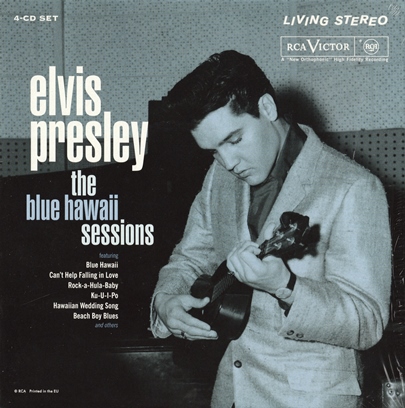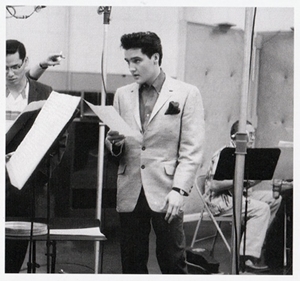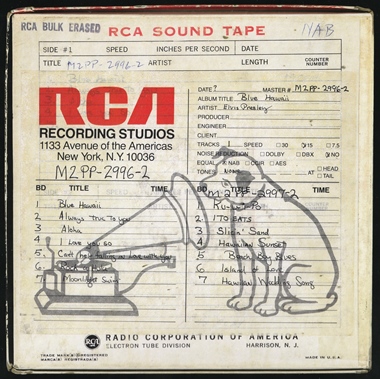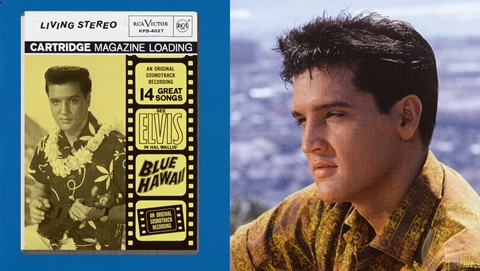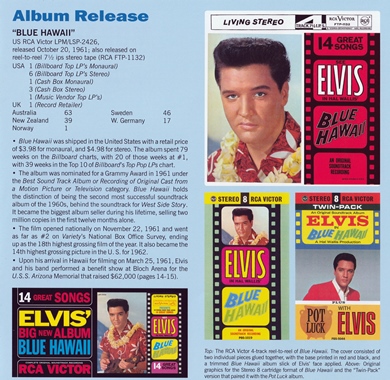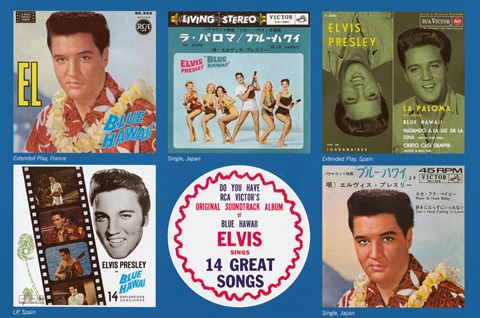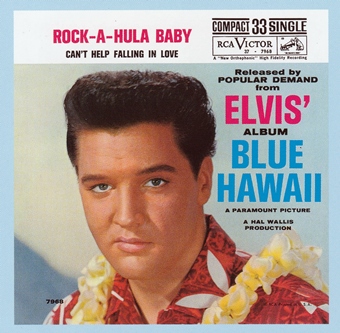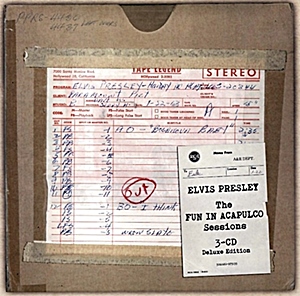‘The Blue Hawaii Sessions' FTD Box-set Review
Released in April 2024 Blue Hawaii is the 11th release in FTD’s (complete) "Sessions” series.
The Blue Hawaii Sessions
Elvis’ Blue Hawaii soundtrack recordings are probably the most released sessions that he ever did. The bootlegs started way back in 1987 with Laurel records ‘The Blue Hawaii Box’ a three album vinyl set containing almost the complete session. It was also in glorious quality. A vast number of bootleg vinyl and CD releases then copied from this vinyl release.
RCA / FTD have also released plenty of Elvis’ Blue Hawaii sessions starting with the expanded 1997 ‘Blue Hawaii’ BMG CD and later the fabulous 2009 FTD Blue Hawaii ‘Classic Album’, plus various outtakes used on ‘Close Up’, FTD’s ‘Silver Screen Stereo’, ‘Elvis For Everyone’ and others.
The MRS label (using the EU Public Domain 50-year rule) also put out 'Blue Hawaii - The Expanded Alternate Album' in 2012 which included a pile of unreleased outtakes that at the time had not been officially released.
This brand new near-complete ‘The Blue Hawaii Sessions’ 4cd set was originally released in ‘The Making Of Blue Hawaii’ FTD Deluxe CD / Book combo.
The FTD publicity promised “4 compact discs featuring 50 unreleased takes with the songs sequenced in recording order for the first time. The soundtrack recording sessions are newly mixed from the original 3-track tapes.”
The Audio
This set has been remixed by Vic Anesini and mastered by Jan Eliasson and the audio sounds truly splendid with a lovely bass and a real top-end clarity.
Vic Anesini also remixed the original 3-track tapes for the FTD Blue Hawaii “Classic Album” and so there is very little noticeable difference between the mixes on these two releases.
I must also note that the Sebastian Jeansson remaster of Vic Anesini’s remixes on the FTD “Classic Album” sounded equally impressive.
The annoyance for collectors is that the long-awaited ‘Can't Help Falling In Love’ Takes 1- 12 are not “newly mixed from the original 3-track tapes” and are taken from the old vinyl bootleg with improved re-mastering. Sadly Ernst Jorgensen never managed to obtain the missing studio reel from a private collector.
However it has to be noted that these twelve early attempts run less than 13 minutes in total and include only one complete take, so this missing tape-reel although very disappointing is not the greatest loss.
Throughout Elvis' recordings with The Jordanaires the backing singers would be placed on the right channel. To hear otherwise usually sounds strange but 'Blue Hawaii' was a real anomaly in that the original vinyl recording had the backing-vocals placed on the left channel and this is the audio configuration here.
The four CDs total 248 minutes (with the masters repeated), so compared to the excellent FTD Blue Hawaii ‘Classic Album’ that ran 158 minutes, collectors only get 56 minutes from the 50 previously unreleased takes that are included on this set.
Note the "RCA BULK ERASED" sticker!
The Package
Continuing FTD’s “Complete sessions” concept there is plenty to explore for Elvis collectors.
The 4 CDs are in a four panel fold-out with the joy of fans being able to pore over various RCA paperwork and tape boxes. Thorne Nogar was the engineer at Hollywood RCA Radio Recorders with Paramount’s Joseph Lilley and musical director Charles O’Curran also having some input.
The large 8-inch 24-page booklet is a nice upgrade from the previous Classic Album booklet again with surprisingly few images being repeated and some great studio shots of the musicians that I haven’t seen before. There is a great shot of Alvino Rey (Steel guitar) with Hank Garland, Scotty Moore and DJ Fontana – and they are all wearing ties and suits! (see below)
David English provides a fascinating 8-page summary about the sessions with some lovely recollections from most of the musicians, composers and producers involved. While obviously taken from the FTD book these are the perfect notes for those fans that could not afford the book or that only wanted to buy the audio.
Drummer Hal Blaine explains.. Paramount Pictures cost was no object, they used to guarantee me a very good rate per day to work with Elvis, to not take record dates as such, and just keep myself available to Elvis, because Elvis worked so hard himself, he automatically created harder work for other people.
I mean, if you go in and work with some star who really doesn't give a damn, you know, who's lackadaisical about everything, it's like "that's good enough," you know, "that's close enough," "that's good," and everyone on the set is gonna be the same way, but when Elvis really wanted it to be right, you know, and everyone sees this going on, and everyone sees Elvis saying, "I want this just right, let me do this again," and "I want to do this properly," then everyone falls into that same routine - consequently we got hit records and hit movies.
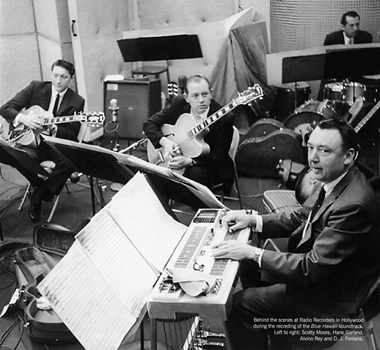 |
Reading about musicians like Dudley Brooks, guitarist Tiny Timbrell, Boots Randolph, Hal Blaine, Alvino Rey plus composers Don Robertson, Luigi Creatore, Dolores Fuller and discovering what they thought of Elvis and what input they had into these sessions makes listening to the multiple outtakes all the more enjoyable.
Choreographer Charles O'Curran: I remember in Blue Hawaii where Elvis had his inevitable brawl and went to jail. There he sang "Beach Boy Blues" in which he referred to his pineapple-growing family and his predicament in these words, "I'm a kissin' cousin to a ripe pineapple and I'm in the can!" Several times, he completely broke up while we were recording that one!
It was my job, in fact, to study the script and the songs and make sure they merged without slowing down the story-line.
First we would record all the songs in a recording studio, and then on the set play back the tapes as the visual part of the picture was filmed. This often meant that I had to make Elvis, who did not need to sing, just move his hips in time to the recording, and look as if he was singing. Sometimes I had to coax him along like a cheerleader, leaping about behind the camera and telling him to mimic me. Can you just imagine it, a middle-aged man jumping about showing the man they called "Elvis the Pelvis" how to shake, rattle and roll! Ah, the secrets of film making.
With multiple pages of memorabilia - including a fascinating list of suggested songs many of them crossed out - international record covers and plenty of photos of Elvis at the time - such as at the Pearl Harbor benefit - the booklet is a delight. It is just a shame it isn’t the usual 28 pages.
Seeing RCA engineer Thorne Nogar’s comments on the tape boxes such “Bad Distortion on Elvis” which we have always heard on the ‘Steppin Out Of Line’ master (see image below) all add to our understanding of this 1961 session.
In one photo Col Parker appears with his famed “Snowmen” at the movie’s wrap party. Did anyone really think that was really funny or even appropriate at the time?
While obviously not as creative or important as Elvis’ early sixties studio LP recordings (Elvis Is Back, Something For Everybody, Pot Luck) having the near-complete session assembled here helps demonstrate Elvis’ real dedication in getting even a movie soundtrack perfect.
Personally I enjoy Elvis’ movie soundtracks when they had some kind of different ethnic musical influence, so the Polynesian sounds of Blue Hawaii do make this session more appealing to me.
Luckily for us the majority of the tracks took around 10 studio attempts to cut the Master so most songs are wrapped before they become repetitious. Here only two songs ‘No More’ and ‘Can’t Help Falling In Love’ go beyond 16 takes and the 25 minute mark.
The following are officially previously unreleased – most of them false starts
Hawaiian Sunset – Take 5, Take 4 & 7 (Both complete, used for spliced master)
Aloha Oe - Take 2, Take 3, Take 4
Ku-U-I-Po - Take 8
No More – Take 3, Take 5, Take 10, Take 12, Take 13, Insert Ending Take 14 & Take 16
Slicin' Sand - Take 9, Take 11, Take 12, Take 17, Take 18
Ito Eats - Take 3, Take 7, Take 8
Island Of Love - Take 3, Take 5, Take 10-11-12
Steppin' Out Of Line (Movie Version) Take 1-2-3, Take 6. (Record version) Take 9, Take 12-13-14
Almost Always True - Take 1
Can't Help Falling In Love - Takes 1- 12 (not from studio tapes) – Take 18, Take 27 – 28
Beach Boy Blues - Take 1
Rock-A-Hula Baby - Take 4
Note that the vast majority of these have been previously released on bootlegs but on this set at last they sound pristine.
The Music.
If you are interested in this new near-complete Sessions set then it must be for the music, so let’s check out the recordings in-depth.
Disc 1 – The Masters and March 21, 1961 Sessions Part1 – 51 minutes
CD 1 starts with The Original Album plus the ‘Bonus Song’ Steppin' Out Of Line. These all sound superb and you cannot believe this bristling audio quality can come from 60 year old tapes.
Sadly Elvis’ vocal is distorted on ‘Steppin' Out Of Line’ since it was recorded that way.
The March 21, 1961 Sessions Part 1
The recordings started with Hawaiian Sunset and immediately we start to understand how the session would work. With its cool swing and Polynesian swaying rhythms and Hawaiian instrumentation Elvis must have felt happy that he really was recording a musically themed soundtrack album and not watered down rock’n’roll.
The first take was in a lower key and at a slower tempo sounding very different to the final version. Elvis is deliberately careful with the lyric, though slips up mid-song. It is a delightful first take with the nice touch when Elvis messes up the sliding-scale at the end. What I do not understand here is that on the FTD ‘Classic Album’ engineer Thorne Nogar makes the perfect comment at the end "That’ll give you a rough idea" but that comment is missing here! Why?
Similarly Take 3 has the first 10 seconds missing here compared to the 'Classic Album' which included two ‘Take 3’ announcements and Elvis commenting “What’s that again Charlie?” Fortunately this issue of missing dialogue doesn’t seem to repeat.
Take 4 is previously unreleased and was used for the first section of the spliced master.
“New” Take 5 fails after 4 seconds while the previously unreleased Take 7 (last section of the master) has Elvis holding the notes much more firmly in the last verse.
As always, rounding off the session we get the final Master cut, but with no extra ‘Count-In’ it is the same as track 11 featured earlier on the same CD.
Disc 2 – The March 21, 1961 Sessions Part 2 – 72 minutes
Aloha Oe
Take 1 - Another Polynesian delight featuring delicious vocals and harmonies which runs just a minute since it was only the second part of the song that featured Elvis. Self depreciatingly Elvis says, "Wait a minute. Better not have me up too loud as I’m not sure I know this well enough!"
“New” Take 2 has Elvis sounding more reassured but reticent on the “’til we meet again” ending. New Take 3 is very similar while Take 4 fails immediately. Take 5 is very good.
Take 6 then has a different ending with Elvis pausing for a line before the big ending. Eavesdropping on the session there is some interesting discussion when musical director Joseph Lilley tells Elvis that it doesn’t work without him “I wish you’d sing that last part”.
Take 7 and Take 5 were spliced for the Master with backing-group The Surfers section 1 used as the start.
Ku-U-I-Po
With delightful harmonies and Alvin Rey’s delicious Hawaiian slide guitar, the first take “Ok, we’re rollin’ fellows” sounds more intimate than the final Master. On Take 2 the arrangement and harmonies have matured since the early first take but Elvis stops halfway through, “I wasn’t expecting that”.
Nearly all of this session was previously released on the ‘Classic Album’ but there are a few more seconds of eavesdropping here between the takes. Take 5 is pretty close to the Master while Take 7 with the louder slide guitar is so good that it is hard to believe that Elvis pushes for yet another take.
Previously unreleased Take 8 fails half-way through with Paramount's Joseph Lilley then telling the group “No marimbas in the introduction.” Take 9 would be the master.
While it is “only” a soundtrack song Elvis would return to it in the seventies so hearing the whole session and Elvis striving for perfection is a treat.
No More
It takes a fair while for Elvis to finish this delightful Latino number. Obviously having rehearsed the song Take 1 starts with Joseph Lilley explaining, "It’s a new tempo, a little slower, easier now" and indeed the first few takes are slower than the master.
Elvis notes, "Give me a sign Dudley, I can’t tell what’s going on in here."
Again this is interesting to hear Elvis and the band’s progress with the tricky song's phrasing, Italian feel and demanding ending.
“New” Take 3 has Elvis noting "Not too fast" as he still feels his way with the melody while “new” Take 5 has the classic ending where Elvis says, "Let’s take it again quick. I got carried away and forgot to look at the lyrics!"
Takes 7 and 8 are both fine versions and with a very different arrangement you notice the slower feel with the rhythm not as staccato and also missing the extra percussion of the Master.
“New” Take 10 is so close to complete but Elvis gives up on the second last line! Take 11 is a little mannered while the neat new addition Take 12 has Elvis practicing the ending and noting, “Let’s see if we can get it right”. Take 13 would be the master expect for the spliced “power” ending. The Insert Endings that follow again demonstrate how serious Elvis was about getting it right.
Slicin' Sand.
It's hard to believe that they worked so long on this beach/rock song with Take 19 as the Master. Several of these takes are silly and fun and there is fabulous humour in Elvis’ voice. The band really rocks on the first take with Hal Blaine attacking the drums but it soon falls apart with Elvis saying, "Hold It. Down with the brake" and then Take 2 is funny with Elvis messing up saying, "Take off your shoes and get somewhere … oh Hell!"
Take 3 is one of the highlights taken at a faster tempo and with more punch than the Master. The Scotty Moore guitar solo is a mess but far more rock’n’roll than the final cut. The ending is also fantastic as the Jordanaires miss their parts and with Elvis joking in a southern drawl, "You boys forgot your parts over there just a little bit!"
Take 6 Elvis kicks off by saying, "Hit it, hop to it!" and includes an extra verse with the lyric ‘Sand in my sandwich!’ It all breaks down with Elvis laughing "oh shit! Sand in my sandwich? What the hell?!"
The session continues in a similar way and to be honest “new” takes 9, 11, 12 are very comparable to the previous failed attempts.
It is before Take 15 that Elvis sings an altered line from 'There's Always Me' "When the evening shadows fall and you're wondering who to ball" which is a nice touch of silliness. This was supposedly a word-up from Elvis to composer Don Robertson (who happened to be in the studio that day) to show how he recorded his song for ‘Something For Everybody’ the previous week. On the actual take The Jordanaires then mess up, "Too many wops in there" jokes Elvis.
“New” Take 17 is however a great addition with Elvis throwing in all of his vocal mannerisms and having fun but obviously knowing it would never be a final take. Listen out for Elvis’ unusual "Ah,ha,ha" at@2.36. I can’t believe Elvis tried so many takes on this lightweight number! Take 19 was the master and near Midnight they called it a day.
DISC 3 – The March 22, 1961 Sessions – 74 minutes
Blue Hawaii
The title song started their second day of recording and all this session was released on the FTD ‘Classic Album’. The first two takes get nowhere before Elvis notes, "OK, I got it." Complete Take 3 is basically a good first rehearsal where Elvis sound reticent in his vocals, and even the melody at points. The tempo also slows down, as the band isn’t so sure either. Paramount producer Joseph Lilley suggests "let’s play this back to listen to it anyway".
It’s an enjoyable start to the day as everyone, including Elvis, has trouble with the 'shuffle’ and mixed tempo of the song. Elvis notes, "I’m getting confused between these tempos" while on Take 5 he correctly berates the musicians saying, "Fellas, we’re going in to a damn shuffle there when we’re not supposed to."
Again it’s an insight into a movie soundtrack session and who would have thought that such an easy-going song would actually be that complicated to record.
Ito Eats
Unlike the silly ‘Big Boots’ on G.I. Blues at least this had a calypso sound to give it a reason for being on the soundtrack. Elvis has trouble with the melody and maybe the awkwardness of these takes along with Elvis’ laughter makes this silly song more listenable. (maybe not!)
“New” Takes 3, 7 and 8 are similar to other takes with Elvis annoyingly confused by the lyrics. Luckily it is all wrapped up in ten minutes. I wonder if Elvis ever thought that this song would actually make it on to the album.
Hawaiian Wedding Song
This session was featured in the FTD ‘Classic Album’ and all done in just two takes. The first take is very similar to the Master take 2. They must have practised hard beforehand and only a slight unsureness of the Hawaiian lyrics would have stopped the very first attempt from becoming the final release.
Island Of Love
There’s more studio fun as Elvis falls off his chair and along the way gets "A frog and a tadpole" in his throat. This was another great track with a superb Hawaiian feel and the earlier takes are at a much slower tempo.
On Take 4 listen at 2.44 to Elvis singing the break "her palm trees gently do the hula, as her slaves the waves" as he has difficulty with the phrasing and words. Although messed up, the band and Elvis continue until Elvis mistakenly then carries on over the instrumental break.
After Take 7 there is a cute joke when Joseph Lilley explains to Elvis that it is "Cow"-ee. "Fine, Cow are you" Elvis laughingly replies.
By Take 9 they have speeded up the tempo to match the released version and Elvis makes the lovely quote "A wise men changes his mind, a fool never does."
“New” takes Take 10-11-12 go nowhere and only fail for simple musician mistimings. Take 13 was the master.
Steppin' Out Of Line
This set contains eight “new” outtakes but sadly none of them run longer than 15 seconds and five of them last only 4 seconds. However having them in context does help explain why this simple rocker took so many attempts to get right.
The first few takes which are for the Movie Version are fun especially listening to Hal Blaine’s tight drum intro and with Elvis joking, “we’re going through them aren’t we?”
Take 4 gets an extended start.. "We’ve got some crazy intros" laughs engineer Thorne Nogar and there is a discussion on shortening the intro.
Take 5 is a real treat when the band’s timing messes up, Elvis singing roughly but with a great rehearsal feel. The take breaks up halfway through with Elvis commenting, "Supposed to be a break there fellows!" Elvis then talks with Dudley Brooks who is obviously the band leader on this session.
One delight for completists is the ending of Take 8 which now runs for an extra ten seconds with the band and Boots Randolph still going in a relaxed playoff.
The earlier takes have a better sound than the Master and you can hear Elvis’ vocal distortion start on Take 10. Again there is more studio discussion included here about what they are doing wrong, “Before his solo, don’t break the rhythm, keep the rhythm going,”
Take 15 was first on ‘Close Up’ but for obvious reasons as this is so damn good. Elvis sounds like he is really enjoying himself, probably because this is more like the rock’n’roll spirit of ‘Elvis Is Back’. This is raw and rough with a roaring saxophone solo by Boots Randolph. Listen @1.31 for Elvis’ "Yah" as he eggs along Boots on the solo. The ending is a true classic with Elvis growling and the drums falling apart delightfully. Thorne notes, "I liked it". The next complete Take 17 was the record master.
The following “Movie tag” is fabulous for being able to eavesdrop on the band working in the studio and listening to their own playback before syncing up the movie ending tag as a splice.
The shorter “Movie Master” follows running 1.32. The unedited longer version appears on the FTD ‘Classic Album’.
Almost Always True
The earlier takes are at a much faster tempo and there’s some delicious studio banter here as Elvis tries to work out the phrasing. Elvis has trouble working out how the lyrics will fit, as he has to leave gaps for the extra dialogue in the film itself. “New” Take 1 is delightful as mid-song Elvis coughs but the band continue in their merry way.. Elvis laughs, "Hold It! Goddamn, hold It!"
Complete Take 3 was surely good enough for this frivolous number even if Elvis laughs towards the end. With a simpler arrangement it’s real fun. Again Elvis chats with Dudley Brooks noting, "Fellas, that's not so easy to do with a rhythm song."
Although it is such lightweight number there is still the enjoyment of it featuring Boots Randolph’s "Yakety Sax". By Take 5 they have slowed the tempo down after Elvis complains to Joseph Lilley, "It’s hard to get all these words out at this fast tempo."
Again we hear previously unreleased studio banter which adds interest to the whole session. Before Take 6 Elvis gets serious noting, “Let’s go! Thorne sit down, you ain’t going out!”
Take 8 was the master.
DISC 4 – The March 22 continued & March 23 1961 Sessions – 51 minutes
Moonlight Swim
On Take 1 Elvis has trouble working out where the future female girl overdubs will be added and misses his intro into the second verse.
Take 3 would be the master but here we get the full-version which goes ten seconds past the fade-out and shows that Elvis then starts laughing and singing in a silly voice. This explains why there was yet another post-master Take 4 where Elvis again deliberately messes up the fade out.
The March 23, 1961 Sessions
'Can't Help falling In Love'
Immediately this session starts you can hear background VINYL rumble! These “new” takes 1>12 are definitely not “newly mixed from the original 3-track tapes” and for Elvis cd collectors the audio quality is surprisingly similar to the 2012 MRS ‘Blue Hawaii: The Expanded Alternate Album” version.
In the initial takes Elvis is unsure asking, "Is that intro right Charles?" but then sounds very calm and understanding even when struggling through so many takes. Being such a stunning song it’s not so difficult to listen to 29 attempts over the thirty minutes that they take.
Amazingly "new" early Take 5 is near complete and is an absolute gem featuring less ukulele and less backing-vocals. Elvis drifts off the melody but it’s a great early version. It was after lunch and Elvis comments, “I ate too much”. On Take 7 Elvis stops noting, "Did you hear that (lyric) paper rattling?" and jokes "I’m shaking with my left leg!"
Listening to the complete session it is fascinating to hear Elvis trying to remember the melody - “Shit. Hold it. Hot damn tamale. How does it go again?” he asks – when we all know Elvis would eventually sing it over 1000 times live in concert!
“New” Take 9 is a delight and a near perfect Movie version. "Ok, fellows let’s pop to it" Elvis says hoping for a Master take but unfortunately he still sounds a little reticent with his vocal at the start.
Take 13 has us back to the “original 3-track studio tapes” and is a real delight. Beforehand Elvis explains that he’s running out of puff, "I get breathy!" while joking, "Ok, Take 40!" - little did he know what was coming!
The great eavesdropping continues with Elvis noting that he has an issue - "Damn pants too tight!" and also adds that, "If they say bad things, they don’t tell me."
By Take 19 Elvis is getting very frustrated with the lack of progress and laughs, "Damn it to hell." There are some classic Elvis quotes and some good discussions as our favourite singer comments, "If you leave me hanging there man, I can’t hold a note worth a damn." And also, "I might be able to struggle through this song."
It’s only on “new” takes 27/ 28 that they finally change to the 'Record master' Dudley Brooks piano intro, even though these both run less than 20 seconds. Even though they are so far into the session Elvis still has to note, "we lost the tempo." The Master would be the very next take!
Beach Boy Blues
For some reason “new” Take 1 was missed off the ‘Classic Album’ but is an interesting addition as you can hear Elvis and the band rehearse in the background. Take 2 is the record master.
On Take 3 Movie Version we get the “new” added intro of Elvis snorting like a horse! Amazingly the two needed different cuts were done in only three attempts.
Rock-A-Hula Baby
This is a joy to listen to as it was the final song and everyone is in great humour and again we get extra studio banter here. It’s is a truly enjoyable end to the lengthy session. Elvis jokes, “Don’t roll it. Hold it. At Ease!” No one is ready but Thorne Nogar suggests, “We’ll put it on tape to see what we make of it”.
Elvis asks of the backing-vocals, “Can you do it in a bass voice?” but Charles O’Curran disagrees.
Take 2 has a nice punchy start but fails as soon as Elvis gets halfway through the first verse. It is however a gem as they are all having so much fun that the band continues until Elvis shouts, "Hold It!"
Take 3 is a true gem for being rough and wilder than the final release. Elvis misses his timing slightly but who cares! A classic.
“New” Take 4 is great to have even if it falls apart halfway through as it is somewhere between the "rockier" Take 3 and the smoother Master (Take 5) that follows.
Even though ‘Rock-A-Hula Baby’ was the final track cut at the session it has never sounded like a finished Master to me with the band still sounding out of tempo at times. Perhaps Elvis had had enough and wanted to head on home never thinking that this piece of "movie fluff" would be a big selling single.
Additional Notes
1. Having finished at the RCA studio Elvis and the band then flew to Hawaii to perform their live concert at Pearl Harbor 2 days later on Saturday March 25. Filming would then start the following Monday. It was an intense month of work for Elvis with the Something For Everybody sessions a total of 27 songs recorded - multiple gold records and possibly his best concert of all time and all completed in just one month.
2. The audio quality is sensational BUT fans can feel rightly let down by the “new” 'Can't Help Falling In Love' outtakes being copied from the old bootleg. FTD should have been honest in their publicity as I am sure it still wouldn’t have affected their overall sales.
3. While I truly enjoyed listening to these “near complete” Blue Hawaii sessions they also proved to me what a fantastic job Ernst Jorgensen did in compiling the 2009 FTD Blue Hawaii “Classic Album”. The concept that was used of 'Original Album', ‘Movie versions’, ‘First Takes’ and then “best of outtakes” also created an extremely enjoyable musical journey. If you are not a super-fan of Elvis’ Blue Hawaii soundtrack material then the ‘Classic Album’ is probably all you need.
Overall Verdict: If you enjoy the Blue Hawaii soundtrack then this is another excellent “complete sessions” set. The new audio remaster from the studio tapes sounds sensational and the “new” studio outtakes are a delight to listen to. Hearing the session chronologically is also a real pleasure with the new snippets of studio banter adding to our understanding of Elvis’ early sixties post-army professionalism. Of course the rather lightweight soundtrack songs can't compete with the creativity of 'Something For Everybody' recorded only 10 days previously but with Elvis’ good humour and some fascinating eavesdropping along the way this is what these “complete sessions” releases are all about.
Review by Piers Beagley.
-Copyright EIN April 2024
EIN Website content © Copyright the Elvis Information Network.
Click here to comment on this review
Note the review images are low-res personal scans and are far worse quality than the stunning images in the FTD release. |
 |
'The Blue Hawaii Sessions' - Special 4-CD Deluxe release.
FTD April 2024 release #506020-975856
Album produced and art directed by Ernst Mikael Jørgensen & Roger Semon.
Mastered and Mixed by Jan Eliasson and Vic Anesini. |
CD 1 The Masters:
01. Blue Hawaii (2:34) 02. Almost Always True (2:22) 03. Aloha Oe (1:53) 04. No More (2:20) 05. Can’t Help Falling In Love (3:01) 06. Rock-A-Hula Baby (1:56) 07. Moonlight Swim (2:18) 08. Ku-U-I-Po (2:21) 09. Ito Eats (1:23) 10. Slicin’ Sand (1:35) 11. Hawaiian Sunset (2:33) 12. Beach Boy Blues (2:03) 13. Island Of Love (2:38) 14. Hawaiian Wedding Song (2:49) 15. Steppin’ Out of Line (1:52)
March 21, 1961 - Radio Recorders, Hollywood:
16. Hawaiian Sunset (AO) take 1 17. Hawaiian Sunset (AO) take 2 18. Hawaiian Sunset (AO) take 3 19. Hawaiian Sunset (AO) take 4 (used for master) 20. Hawaiian Sunset (AO) takes 5-6, 7 (used for master) 21. Hawaiian Sunset (AO) (final master) (splice of take 4 & 7)
CD 2 March 21, 1961 - Radio Recorders, Hollywood:
01. Aloha Oe (BO section 2) take 1 02. Aloha Oe (BO section 2) take 2 03. Aloha Oe (BO section 2) take 3 04. Aloha Oe (BO section 2) takes 4, 5 (used for master) 05. Aloha Oe (BO section 2) take 6 06. Aloha Oe (BO section 2) take 7 (used for master) 07. Aloha Oe (BO 1 - master) (take 4) & (BO 2 - master) (splice of take 7 & 5) 08. Ku-U-I-Po (CO) take 1 09. Ku-U-I-Po (CO) takes 2,4,5 10. Ku-U-I-Po (CO) takes 6-7 11. Ku-U-I-Po (CO) takes 8, 9 (master) 12. No More (DO) takes 1-2 13. No More (DO) takes 4, 5, 7 14. No More (DO) take 8 15. No More (DO) take 9 16. No More (DO) takes 10-11 17. No More (DO) takes 12,13 (used for master) 18. No More (DO-1) (insert ending) takes 14-16 19. No More (DO & DO-1) (master) (splice of take 13 & ending take 16) 20. Slicin’ Sand (EO) takes 1-3 21. Slicin’ Sand (EO) take 4 22. Slicin’ Sand (EO) takes 5-7 23. Slicin’ Sand (EO) takes 8-9 24. Slicin’ Sand (EO) take 10 25. Slicin’ Sand (EO) takes 11-12 26. Slicin’ Sand (EO) takes 13-14 27. Slicin’ Sand (EO) takes 15-18 28. Slicin’ Sand (EO) take 19 (master)
CD 3 March 22, 1961 - Radio Recorders, Hollywood:
01. Blue Hawaii (FO) takes 1-3 02. Blue Hawaii (FO) takes 4-6 03. Blue Hawaii (FO) take 7 (master) 04. Ito Eats (GO) takes 1-2 05. Ito Eats (GO) takes 3-5 06. Ito Eats (GO) takes 6-8, 9 (master) 07. Hawaiian Wedding Song (JO) take 1 08. Hawaiian Wedding Song (JO) take 2 (master) 09. Island of Love (KO) takes 1-4 10. Island Of Love (KO) takes 5-7 11. Island Of Love (KO) take 8 12. Island Of Love (KO) take 9-10 13. Island Of Love (KO) takes 11-12 14. Island Of Love (KO) take 13 (master) 15. Steppin’ Out Of Line (LO) (movie version) takes 1-5 16. Steppin’ Out Of Line (LO) (movie version) takes 6-7, 8 (master) 17. Steppin’ Out Of Line (LO) (record version) takes 9-11 18. Steppin’ Out Of Line (LO) (record version) takes 12-15 19. Steppin’ Out Of Line (LO) (record version) takes 16, 17 (master) 20. Steppin’ Out Of Line (LO) (movie version) (tag) takes 18-19 21. Steppin’ Out Of Line (LO) (movie version) (master) 22. Almost Always True (MO) takes 1-3 23. Almost Always True (MO) takes 4-5 24. Almost Always True (MO) takes 6-7 25. Almost Always True (MO) take 8 (master)
CD 4
01. Moonlight Swim (NO) takes 1-2 02. Moonlight Swim (NO) take 3 (master without female vocals overdub) 03. Moonlight Swim (NO) take 4
March 23, 1961 - Radio Recorders, Hollywood
04. Can’t Help Falling In Love (RO) (movie version) takes 1-5 05. Can’t Help Falling In Love (RO) (movie version) takes 6-8 06. Can’t Help Falling In Love (RO) (movie version) take 9 07. Can’t Help Falling In Love (RO) (movie version) takes 10-12 08. Can’t Help Falling In Love (RO) (movie version) take 13 09. Can’t Help Falling In Love (RO) (movie version) takes 14-16 10. Can’t Help Falling In Love (RO) (movie version) takes 17-20 11. Can’t Help Falling In Love (RO) (movie version) takes 21-22, 23 (master) 12. Can’t Help Falling In Love (RO) (movie version) takes 24 13. Can’t Help Falling In Love (RO) (movie version) takes 25-26 14. Can’t Help Falling In Love (RO) (record version) takes 27-29 (master) 15. Beach Boy Blues SO (record version) takes 1, 2 (master) 3 16. Beach Boy Blues SO (movie version) take 4 (master) 17. Rock-A-Hula Baby TO (record version) takes 1-3 18. Rock-A-Hula Baby TO (record version) Takes 4, 5 (master).
Credits: Original musical arranger: Joseph J. Lilley. Original engineer: Thorne Nogar. Original editor: Dave Wiechman.
Mixed from 3-track to 2-track stereo by Vic Anesini at Battery Studios, New York, 2022.
Edited and mastered by Jan Eliasson at Audio Planet, Denmark.
Produced by Ernst Mikael Jørgensen. |
'Blue Hawaii' FTD Soundtrack in-depth Review: Blue Hawaii was one of Elvis' biggest-selling albums and most fans would have purchased these songs previously on the original vinyl and then again via BMG's extended 1997 release. Despite it's travelogue style 'Blue Hawaii' has always been one of the essential albums to own even for non-soundtrack fans. So can this FTD extended movie soundtrack release really be the definitive version to make it worth buying all over again. EIN's Piers Beagley puts on his Hawaiian-shirt and digs deep to discover plenty of reasons to enjoy this 2 ½ hours of fun. Can there really be that much to say over this old chestnut? - you betcha'!
(FTD reviews, Source; EIN) |
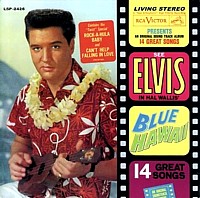 |
'The Pot Luck Sessions' Deluxe FTD Review: Released back in December 2021, 'The Pot Luck Sessions' was the eighth in FTD’s “complete sessions” packages. An 8 inch deluxe 5-CD package featuring a 28-page booklet with an insightful essay, record and session data, memorabilia and rare photos. The set includes remastered complete RCA sessions from Elvis' June 25 and October 15 1961 and March 18-19 1962 recording sessions.
The set features a good number of previously unreleased outakes and EIN also uncovers plenty of Elvis studio discussions that had been previously edited out on earlier "Classic Album" releases such as Elvis saying, “Here we go already. How do like that arrangement, Red?” an important question to his friend Red West who had composed the song 'That’s Someone You Never Forget'.
With the complete Little Sister / His Latest Flame sessions this is the release collectors have been waiting forty years for!
Go here as EIN's Piers Beagley goes in-deep to discover the hidden delights for session collectors....
(FTD Reviews, Source;ElvisInformationNetwork) |
 |
'The Something For Everybody Sessions' Deluxe FTD Review: Released Released back in November 202, 'The Something For Everybody Sessions' (ft 'The Wild In The Country Sessions') was another in FTD’s “complete sessions” releases. An 8 inch deluxe 4-CD package featuring a 28-page booklet with an insightful essay, record and movie data, memorabilia and rare photos. It includes remixed and remastered unreleased studio outtakes - all the RCA session takes from Elvis' RCA November 7 / 8, 1960 and March 12 / 13, 1961 recording sessions.
On close investigation we discover various Elvis comments that had been previously edited out such as, “I’m gonna’ get this son-of-a-bitch” on ‘Give Me The Right’ - while the frustration of the repetitive 'Wild In The Country Sessions' also becomes obvious.
But it there really enough previously unreleased material to makes this session worth purchasing all over again?
Go here as EIN's Piers Beagley checks out this new Deluxe set and discovers some hidden delights for session collectors....
(FTD Reviews, Source;ElvisInformationNetwork) |
 |




